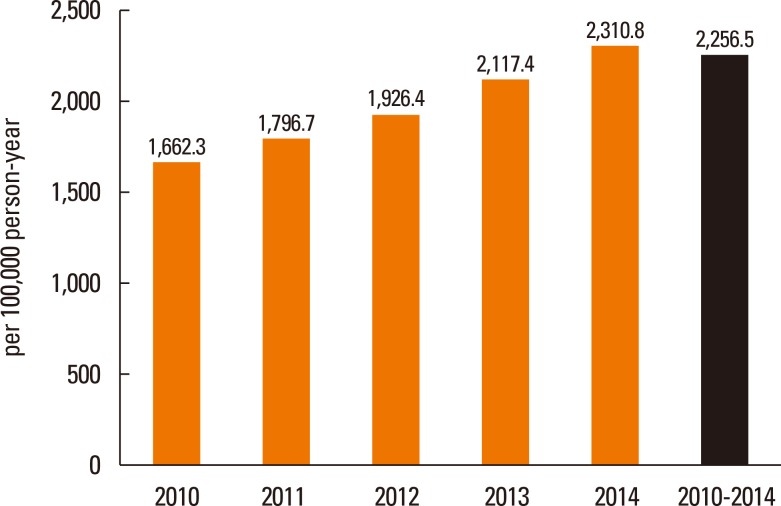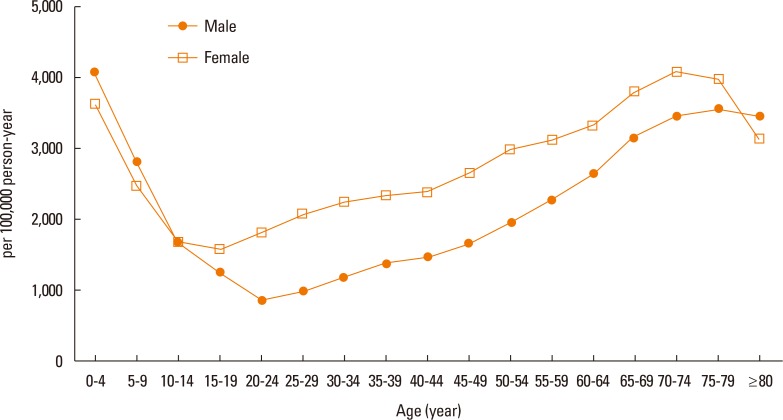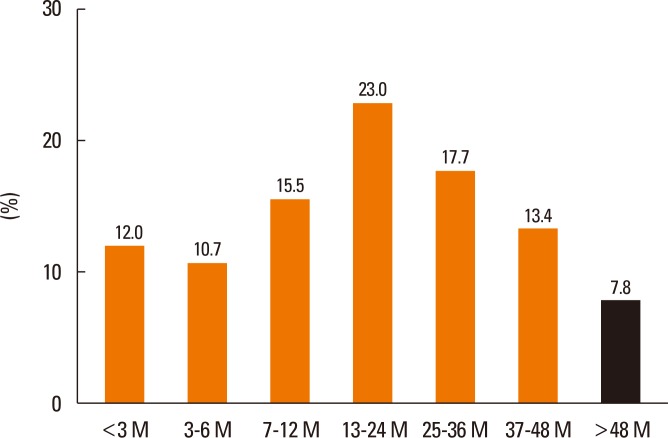Epidemiology of Chronic Urticaria in Korea Using the Korean Health Insurance Database, 2010-2014
- Affiliations
-
- 1Department of Allergy and Clinical Immunology, Ajou University School of Medicine and Graduate School of Medicine, Suwon, Korea. ye9007@ajou.ac.kr
- 2Office of Biostatistics, Ajou University School of Medicine and Graduate School of Medicine, Suwon, Korea.
- 3Clinical Trial Center, Ajou University Medical Center, Suwon, Korea.
- 4Center of Biomedical Data Science / Institute of Genomic Cohort, Wonju College of Medicine, Yonsei University, Wonju, Korea.
- KMID: 2383992
- DOI: http://doi.org/10.4168/aair.2017.9.5.438
Abstract
- PURPOSE
There are very few epidemiological studies on chronic urticaria (CU). We aimed to investigate the prevalence of CU and to depict demographics and medication patterns for the disease in a nationwide population-based study.
METHODS
Data on urticaria (L50 of the International Classification of Diseases, 10th revision) from 2010 to 2014 were obtained from the Korean Health Insurance Review and Assessment Service. Algorithms designed to evaluate prescription drug claims for antihistamines were applied to identify CU.
RESULTS
The crude prevalence of CU was 2,256.5 per 100,000 person-years and tended to increase every year. The age-standardized prevalence of CU was significantly higher in females than in males (2,466.8 vs 1,819.2 per 100,000 person-years, P<0.001). Age-specific prevalence was highest for older adults over the age of 65 years and lowest for ages 10-29 years. The median duration of CU was 591 days, and symptoms lasted for at least 1 year in 61.9% of patients. Gastrointestinal disease was the most common comorbidity in adults, whereas allergic rhinitis and common cold were more prevalent in children with CU. Around a third of CU patients were taking antihistamine treatment alone, and 70% were treated with both antihistamines and systemic corticosteroids. Cyclosporine was prescribed for 0.02% of CU patients.
CONCLUSIONS
The present study outlines recent longitudinal epidemiological data on the prevalence of CU in Korea. In light of limitations on the use of claims data, including no specific disease code for CU and a possible discordance between drug claims and the presence of urticaria symptoms, further investigations are necessary to describe the exact epidemiologic profile of CU patients.
Keyword
MeSH Terms
-
Adrenal Cortex Hormones
Adult
Child
Common Cold
Comorbidity
Cyclosporine
Demography
Epidemiologic Studies
Epidemiology*
Female
Gastrointestinal Diseases
Histamine Antagonists
Humans
Insurance, Health*
International Classification of Diseases
Korea*
Male
Prescriptions
Prevalence
Rhinitis, Allergic
Urticaria*
Adrenal Cortex Hormones
Cyclosporine
Histamine Antagonists
Figure
Cited by 6 articles
-
Dimerized, Not Monomeric, Translationally Controlled Tumor Protein Induces Basophil Activation and Mast Cell Degranulation in Chronic Urticaria
Bastsetseg Ulambayar, Heewon Lee, Eun-Mi Yang, Hae-Sim Park, Kyunglim Lee, Young-Min Ye
Immune Netw. 2019;19(3):. doi: 10.4110/in.2019.19.e20.Updated treatment guideline of chronic spontaneous urticaria
Joo Young Roh
J Korean Med Assoc. 2019;62(1):37-46. doi: 10.5124/jkma.2019.62.1.37.Emerging Therapies in Chronic Spontaneous Urticaria
Taek Ki Min, Sarbjit S. Saini
Allergy Asthma Immunol Res. 2019;11(4):470-481. doi: 10.4168/aair.2019.11.4.470.Adaptation and Validation of the Korean Version of the Urticaria Control Test and Its Correlation With Salivary Cortisone
Ji-Ho Lee, Yoon Ju Bae, So-Hee Lee, Su-Chin Kim, Hyun-Young Lee, Ga-Young Ban, Yoo Seob Shin, Hae-Sim Park, Juergen Kratzsch, Young-Min Ye
Allergy Asthma Immunol Res. 2019;11(1):55-67. doi: 10.4168/aair.2019.11.1.55.Time trends of the prevalence of allergic diseases in Korea: A systematic literature review
Sung-Yoon Kang, Woo-Jung Song, Sang-Heon Cho, Yoon-Seok Chang
Asia Pac Allergy. 2018;8(1):. doi: 10.5415/apallergy.2018.8.e8.Clinical Course of Chronic Spontaneous Urticaria in the Korean Adult Population
Yoon Seob Kim, Sang Hyun Park, Kyungdo Han, Ji Hyun Lee, Nack In Kim, Joo Young Roh, Seong Jun Seo, Hae Jun Song, Min-Geol Lee, Jee Ho Choi, Young Min Park
Allergy Asthma Immunol Res. 2018;10(1):83-87. doi: 10.4168/aair.2018.10.1.83.
Reference
-
1. Bernstein JA, Lang DM, Khan DA, Craig T, Dreyfus D, Hsieh F, et al. The diagnosis and management of acute and chronic urticaria: 2014 update. J Allergy Clin Immunol. 2014; 133:1270–1277. PMID: 24766875.
Article2. Zuberbier T, Aberer W, Asero R, Bindslev-Jensen C, Brzoza Z, Canonica GW, et al. The EAACI/GA(2) LEN/EDF/WAO guideline for the definition, classification, diagnosis, and management of urticaria: the 2013 revision and update. Allergy. 2014; 69:868–887. PMID: 24785199.3. Maurer M, Weller K, Bindslev-Jensen C, Giménez-Arnau A, Bousquet PJ, Bousquet J, et al. Unmet clinical needs in chronic spontaneous urticaria. A GA²LEN task force report. Allergy. 2011; 66:317–330. PMID: 21083565.4. Choi WS, Lim ES, Ban GY, Kim JH, Shin YS, Park HS, et al. Disease-specific impairment of the quality of life in adult patients with chronic spontaneous urticaria. Korean J Intern Med. 2016; Forthcoming.
Article5. Sánchez-Borges M, Asero R, Ansotegui IJ, Baiardini I, Bernstein JA, Canonica GW, et al. Diagnosis and treatment of urticaria and angioedema: a worldwide perspective. World Allergy Organ J. 2012; 5:125–147. PMID: 23282382.
Article6. Kim L, Kim JA, Kim S. A guide for the utilization of health insurance review and assessment service national patient samples. Epidemiol Health. 2014; 36:e2014008. PMID: 25078381.
Article7. Zuberbier T, Balke M, Worm M, Edenharter G, Maurer M. Epidemiology of urticaria: a representative cross-sectional population survey. Clin Exp Dermatol. 2010; 35:869–873. PMID: 20456386.
Article8. Gaig P, Olona M, Muñoz Lejarazu D, Caballero MT, Domínguez FJ, Echechipia S, et al. Epidemiology of urticaria in Spain. J Investig Allergol Clin Immunol. 2004; 14:214–220.9. Zazzali JL, Broder MS, Chang E, Chiu MW, Hogan DJ. Cost, utilization, and patterns of medication use associated with chronic idiopathic urticaria. Ann Allergy Asthma Immunol. 2012; 108:98–102. PMID: 22289728.
Article10. Lapi F, Cassano N, Pegoraro V, Cataldo N, Heiman F, Cricelli I, et al. Epidemiology of chronic spontaneous urticaria: results from a nationwide, population-based study in Italy. Br J Dermatol. 2016; 174:996–1004. PMID: 26872037.
Article11. Toubi E, Kessel A, Avshovich N, Bamberger E, Sabo E, Nusem D, et al. Clinical and laboratory parameters in predicting chronic urticaria duration: a prospective study of 139 patients. Allergy. 2004; 59:869–873. PMID: 15230821.
Article12. Isik SR, Karakaya G, Celikel S, Demir AU, Kalyoncu AF. Association between asthma, rhinitis and NSAID hypersensitivity in chronic urticaria patients and prevalence rates. Int Arch Allergy Immunol. 2009; 150:299–306. PMID: 19494528.
Article13. Kulthanan K, Jiamton S, Thumpimukvatana N, Pinkaew S. Chronic idiopathic urticaria: prevalence and clinical course. J Dermatol. 2007; 34:294–301. PMID: 17408437.
Article14. Fine LM, Bernstein JA. Guideline of chronic urticaria beyond. Allergy Asthma Immunol Res. 2016; 8:396–403. PMID: 27334777.
Article15. Lee SJ, Ha EK, Jee HM, Lee KS, Lee SW, Kim MA, et al. Prevalence and risk factors of urticaria with a focus on chronic urticaria in children. Allergy Asthma Immunol Res. 2017; 9:212–219. PMID: 28293927.
Article16. Suh M, Kim HH, Sohn MH, Kim KE, Kim C, Shin DC. Prevalence of allergic diseases among Korean school-age children: a nationwide cross-sectional questionnaire study. J Korean Med Sci. 2011; 26:332–338. PMID: 21394299.
Article17. Lee SY, Ahn K, Kim J, Jang GC, Min TK, Yang HJ, et al. A multicenter retrospective case study of anaphylaxis triggers by age in Korean children. Allergy Asthma Immunol Res. 2016; 8:535–540. PMID: 27582405.
Article18. Kozel MM, Mekkes JR, Bossuyt PM, Bos JD. Natural course of physical and chronic urticaria and angioedema in 220 patients. J Am Acad Dermatol. 2001; 45:387–391. PMID: 11511835.
Article19. Saini SS. Chronic spontaneous urticaria: etiology and pathogenesis. Immunol Allergy Clin North Am. 2014; 34:33–52. PMID: 24262688.20. Cherepanov D, Raimundo K, Chang E, Eagan M, Zazzali JL, Solari PG, et al. Validation of an ICD-9-based claims algorithm for identifying patients with chronic idiopathic/spontaneous urticaria. Ann Allergy Asthma Immunol. 2015; 114:393–398. PMID: 25771155.
Article21. Delong LK, Culler SD, Saini SS, Beck LA, Chen SC. Annual direct and indirect health care costs of chronic idiopathic urticaria: a cost analysis of 50 nonimmunosuppressed patients. Arch Dermatol. 2008; 144:35–39. PMID: 18209166.
Article22. Gu H, Li L, Gu M, Zhang G. Association between Helicobacter pylori infection and chronic urticaria: a meta-analysis. Gastroenterol Res Pract. 2015; 2015:486974. PMID: 25861258.23. Eusebi LH, Zagari RM, Bazzoli F. Epidemiology of Helicobacter pylori infection. Helicobacter. 2014; 19(Suppl 1):1–5.
- Full Text Links
- Actions
-
Cited
- CITED
-
- Close
- Share
- Similar articles
-
- Epidemiology of urticaria including physical urticaria and angioedema in Korea
- Dermographism ( III ): Dermographism in Acute and Chronic Urticaria
- Adult Onset Still's Disease Developed in Chronic Urticaria Patient
- Chronic urticaria in children
- A Study on Clinical and Etiological Aspects of Chronic Urticaria by Questionnaire





